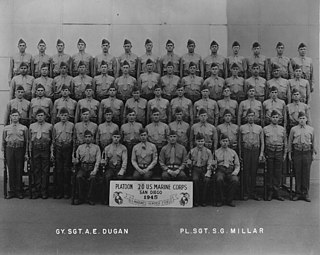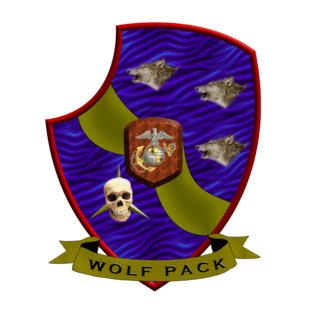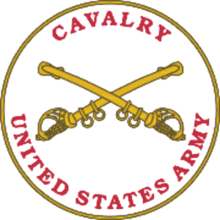A company is a military unit, typically consisting of 100–250 soldiers and usually commanded by a major or a captain. Most companies are formed of three to seven platoons, although the exact number may vary by country, unit type, and structure.

A platoon is a military unit typically composed of two to four squads, sections, or patrols. Platoon organization varies depending on the country and the branch, but a platoon can be composed of 20–50 troops, although specific platoons may range from 10 to 100 people. A platoon is typically the smallest military unit led by a commissioned officer. The platoon leader is usually a junior officer—a second or first lieutenant or an equivalent rank. The officer is usually assisted by a platoon sergeant.

The 11th Armored Cavalry Regiment is a unit of the United States Army garrisoned at the Fort Irwin National Training Center in California. The regiment has served in the Philippine–American War, the Pancho Villa Expedition, World War II, the Vietnam War, Gulf War and Iraq War. The 11th ACR serves as the opposing force (OPFOR) for the Army and Marine task forces, and foreign military forces that train at Fort Irwin.
The School of Infantry (SOI) is the second stage of initial military training for enlisted United States Marines after recruit training. The ITB now called IMC went from a 59 day course to 14 week course. Since the initial training pipeline is divided between coasts, Marines from areas east of the Mississippi River usually graduate from MCRD Parris Island and move on to SOI at SOI East, while those from the western half of the nation attend MCRD San Diego and move on to SOI West at the Camp San Onofre area of Camp Pendleton in California. Female Marines are trained at both SOI East and SOI West. The School of Infantry's training mission ensures "Every Marine is, first and foremost, a Rifleman". At SOI, Marines with the Military Occupational Specialty of infantry are trained at the Infantry Training Battalion (ITB), while all non-infantry Marines are trained in basic infantry and combat skills at the Marine Combat Training Battalion. SOI marks a transition in the professional training of entry-level students from basically trained Marines to combat-ready Marines.

The brigade combat team (BCT) is the basic deployable unit of maneuver in the U.S. Army. A brigade combat team consists of one combat arms branch maneuver brigade, and its assigned support and fire units. A brigade is normally commanded by a colonel (O-6) although in some cases a brigadier general (O-7) may assume command. A brigade combat team contains combat support and combat service support units necessary to sustain its operations. BCTs contain organic artillery training and support, received from the parent division artillery (DIVARTY). There are three types of brigade combat teams: infantry, Stryker, and armored.

3d Light Armored Reconnaissance Battalion(3D LAR BN) is a fast and mobilized armored terrestrial reconnaissance battalion of the United States Marine Corps. Their primary weapon system is the LAV-25 and they are part of the 1st Marine Division and I Marine Expeditionary Force. The unit is based out of the Marine Corps Air Ground Combat Center Twentynine Palms, California.
Reconnaissance, surveillance, and target acquisition (RSTA) groups the tasks of reconnaissance, surveillance and target acquisition conducted by the Department of Defense. RSTA supports military operations at a strategic, operational, or tactical level, either by dedicated RSTA forces or those which possess the capability.

The United States Marine Corps is organized within the Department of the Navy, which is led by the Secretary of the Navy (SECNAV). The most senior Marine commissioned officer is the Commandant of the Marine Corps, responsible for organizing, recruiting, training, and equipping the Marine Corps so that it is ready for operation under the command of the unified combatant commanders. The Marine Corps is organized into four principal subdivisions: Headquarters Marine Corps, the Operating Forces, the Supporting Establishment, and the Marine Forces Reserve.
MOS 0369 is the United States Marine Corps (USMC) Military Occupational Specialty (MOS) for Infantry Unit Leader.

The M1127 Reconnaissance Vehicle (RV) is a wheeled armored personnel carrier in the Stryker family, developed and produced by General Dynamics Land Systems Canada (GDLS-C) and is currently in service with the US Army.
In many militaries, a platoon sergeant is the senior enlisted member of a platoon, who advises and supports the platoon's commanding officer in leading the unit.

The 194th Armored Brigade is a separate brigade of the US Army. All armor, cavalry, and armor and cavalry mechanic soldiers, and Marines in equivalent specialties, are trained by the 194th under the armor component of the Maneuver Center of Excellence at Fort Moore, Georgia, where the 194th has been garrisoned since 2012.

The United States Army Armor School is a military training school located at Fort Moore, Georgia. Its primary focus is the training of United States Army soldiers, non-commissioned officers, warrant officers, and commissioned officers. It also trains for equipment handling, including the M1 Abrams, the Bradley Fighting Vehicle, and the Stryker Mobile Gun System. The Armor School moved to Fort Benning in 2010 as part of the United States Base Realignment and Closure program.

A combined anti-armor team or combined arms assault team (CAAT) is an organization of a United States Marine Corps weapons company where one or more platoons are operated in a detached role to conduct reconnaissance missions and combat ground armored vehicles and air defense vehicles with heavy weapons systems. CAATs often use weapon systems such as M2 .50 caliber machine guns, Mk-19 grenade launchers, and anti-armor missile systems such as BGM-71 TOW missiles and FGM-148 Javelins.

Armoured reconnaissance is the combination of terrestrial reconnaissance with armoured warfare by soldiers using tanks and wheeled or tracked armoured reconnaissance vehicles. While the mission of reconnaissance is to gather intelligence about the enemy with the use of reconnaissance vehicles, armoured reconnaissance adds the ability to fight for information, and to have an effect on and to shape the enemy through the performance of traditional armoured tasks.

The 197th Infantry Brigade is an active Infantry brigade of the United States Army. The brigade was active as an Organized Reserve unit from 1921 to 1942, in the Regular Army from 1962 to 1991, and as a TRADOC training unit from 2007 to 2013. The brigade saw service in Operation Desert Storm with the 24th Infantry Division. On July 31, 2020, the brigade was activated as a training brigade in Fort Moore, Georgia, to serve the increased training needs of the army.

The 1st Squadron, 91st Cavalry Regiment (Airborne) is a light Airborne Reconnaissance Squadron currently serving as the 173rd Airborne Brigade's Reconnaissance, Surveillance and Targeting Acquisition (RSTA) Squadron based out of Tower Barracks in Grafenwöhr, Germany. It is the only Airborne RSTA Squadron within the European, Middle East, and Africa (EMEA) area of responsibility.

The 151st Cavalry Regiment was a United States Army cavalry regiment represented in the Arkansas Army National Guard by 1st Squadron, 151st Cavalry Regiment, headquartered in Warren, Arkansas, an element of the 39th Infantry Brigade Combat Team.

A reconnaissance vehicle, also known as a scout vehicle, is a military vehicle used for forward reconnaissance. Both tracked and wheeled reconnaissance vehicles are in service. In some nations, light tanks such as the M551 Sheridan and AMX-13 have also been used by scout platoons. Their armament ranges from a medium machine gun to a large cannon. Modern examples are often fitted with ATGMs and a wide range of sensors.














